
Get Business Email
No domain name required
Email remains one of the most essential tools for both personal and professional communication. Among the plethora of email services available, Google Mail, widely known as Gmail, stands out due to its user-friendly interface, robust features, and seamless integration with other Google services.
Launched in 2004, Gmail has evolved from a simple email service into a comprehensive platform that supports not only email but also productivity tools, storage solutions, and communication applications. Gmail continues to be the leading email platform globally, boasting over 1.8 billion users as of now.
Google prioritizes user security, implementing features like two-step verification, advanced spam filtering, and phishing protection. These measures ensure that your account remains secure and that your personal information is protected.
With dedicated mobile apps for both iOS and Android, Gmail users can access their emails on the go. The mobile interface is optimized for touch screens, providing a seamless experience for users away from their desktops.
In this article, we will learn a step-by-step process for google mail sign up. It does not require any technical knowledge, and even those with minimal technical experience can create their accounts easily. We will also explore the available alternatives to Gmail that offer free custom email addresses and domains.
Step-by-Step Guide for Google Mail Sign-Up: For Personal Purposes
Here’s a step-by-step guide to setting up Gmail:
Step 1: Visit the Google Mail Sign-Up Page
To initiate the registration process, you first need to access the Google Mail sign-up page.
Open a Gmail account using a web browser such as Google Chrome, Firefox, Safari, or Microsoft Edge. Ensure that your internet connection is stable to avoid interruptions during the signup process.
In the address bar, type www.gmail.com and press Enter. This will direct you to the Gmail home page. If you are on the sign-in page, look for the “Create account” link. It’s usually located below the sign-in fields. Click on it to proceed.
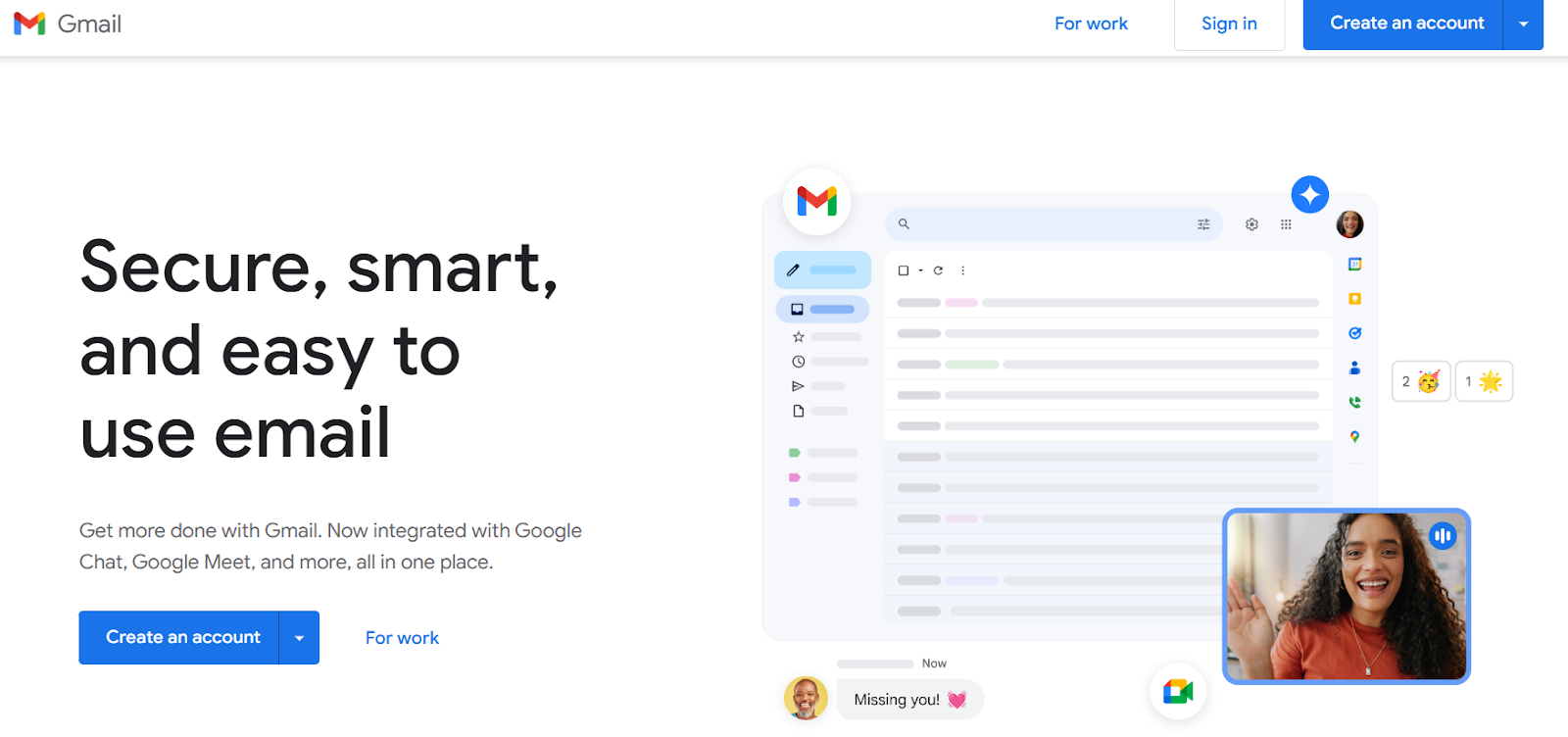
Step 2: Choose Your Account Type to Open your Gmail Account
Upon clicking "Create account," you will be presented with options to specify the type of account you wish to create.
Select "For Myself" or "To Manage My Business.": Choose “For myself” to create a personal Gmail account.
Alternatively, suppose you are setting up an account for business purposes. In that case, you can select “To manage my business,” which will lead you to Google Workspace options, a suite of productivity tools designed for businesses.
Step 3: Fill Out Your Information

Now that you’ve chosen your account type, it’s time to input your personal information.
Enter Your Name: Fill in the fields for your first and last name. Ensure that the names are spelled correctly, as these will be displayed to your email recipients.
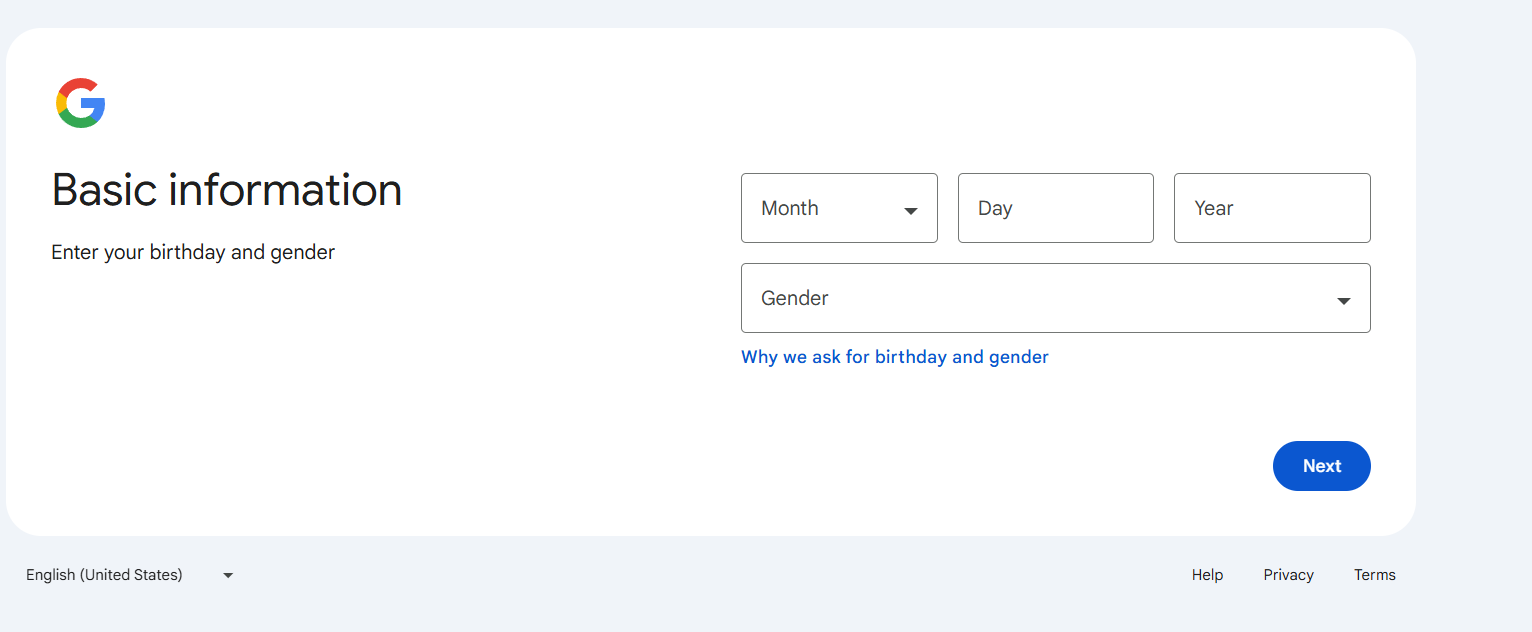
Choose a Username to Open a Gmail Account: In the “Username” field, enter the desired email address (e.g., username@gmail.com). Gmail will inform you if the username is already in use and suggest alternatives if needed. Selecting a memorable and professional username can enhance your communication, especially in a business context.
Create a Strong Password: Enter a password that is at least eight characters long and includes a combination of letters, numbers, and symbols. A strong password is vital for protecting your account against unauthorized access. After typing your password, re-enter it in the “Confirm” field to ensure that both entries match.
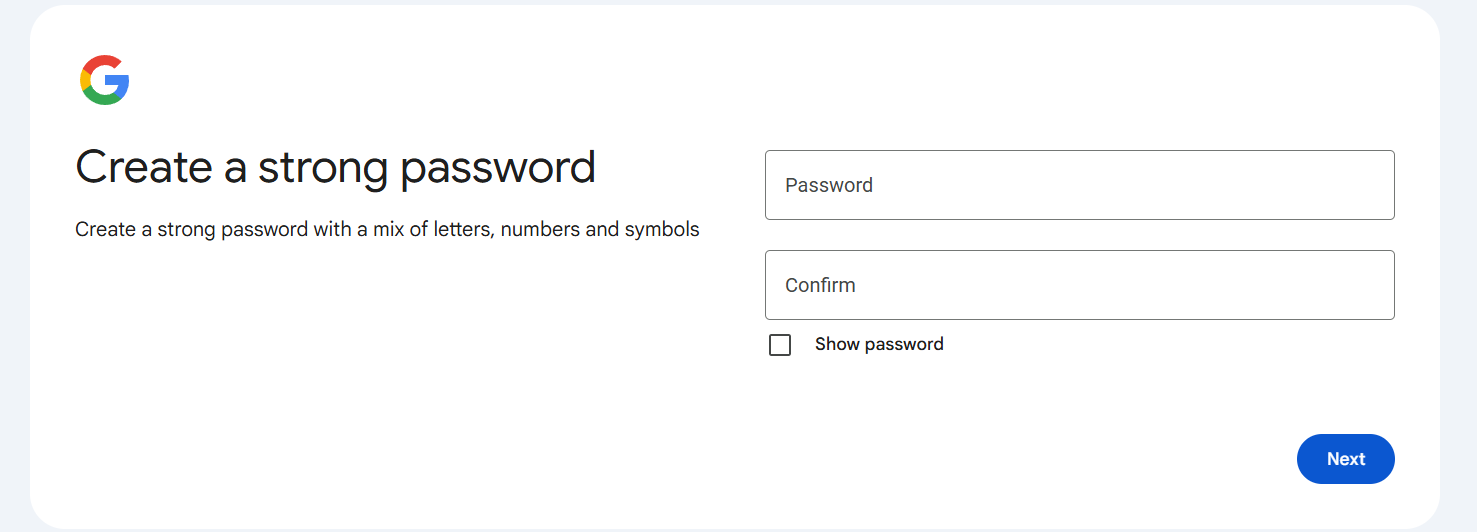
Step 4: Complete the Verification Process
Click "Next": After filling in your information, click the "Next" button to continue.
Phone Number Verification: Google will prompt you to enter your phone number. This step is crucial for account security and recovery. Input your phone number and click “Next.”
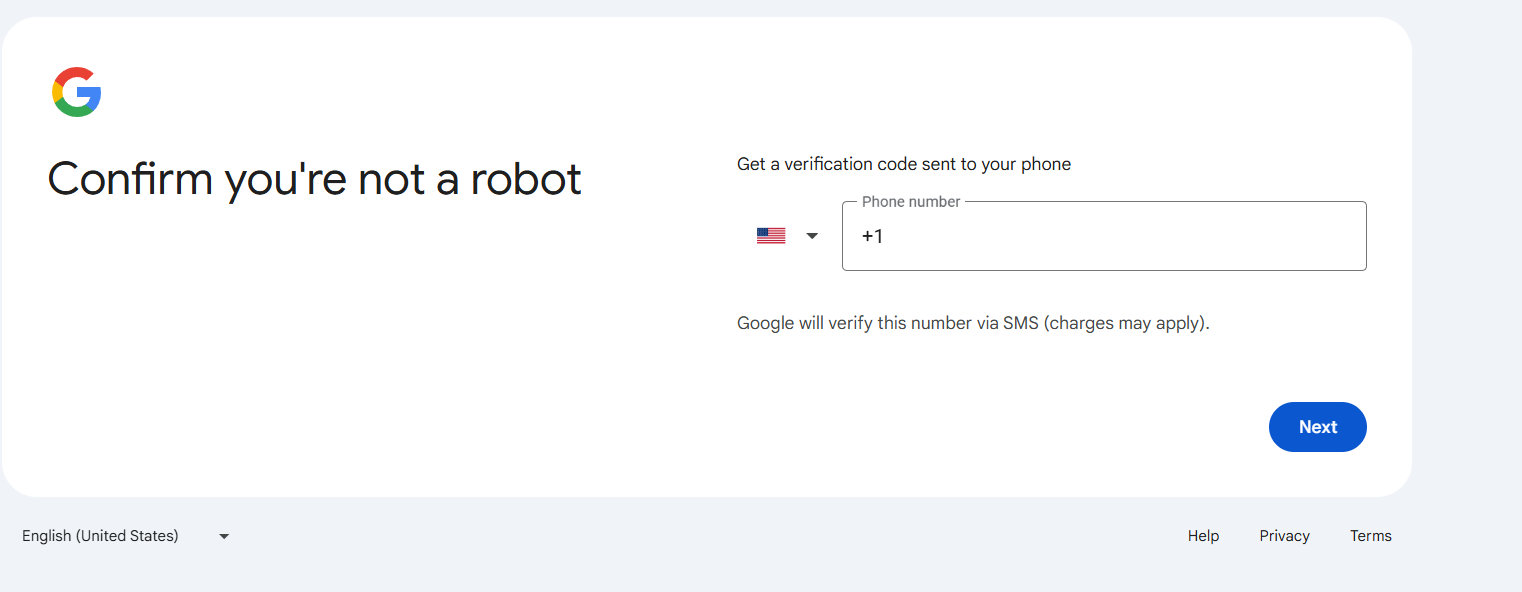
Receive a Verification Code: You will receive a text message containing a verification code. Enter this code into the provided field and click "Verify." This process adds an extra layer of security to your account.
Step 5: Add Recovery Information (Optional)
Recovery Email Address: While this step is optional, it is highly recommended. Enter an alternate email address that can be used for account recovery in case you forget your password or lose access.
Date of Birth and Gender: Fill in your date of birth and select your gender from the dropdown menu. This information helps Google tailor your experience and may also assist in account recovery.
Step 6: Agree to the Terms and Conditions on Google Mail Sign-Up Page
Review Google’s Terms of Service: Before finalizing your account setup, it’s important to review Google’s Terms of Service and Privacy Policy. This information outlines your rights and responsibilities as a user of Gmail.
Accept the Terms: After reading the terms, scroll to the bottom of the page and click the “I agree” button to accept them and proceed.
Step 7: Set Up Your Account to Open Gmail Account
Profile Customization: Google may prompt you to personalize your account by adding a profile picture and setting your email preferences. This step is optional, but having a profile picture can make your emails appear more professional.
Familiarize Yourself with Gmail: Once you’ve completed the setup, you will be directed to your new Gmail inbox. Take some time to explore the interface. Key features to note include the Compose button for sending new emails, the categories in the sidebar (such as Primary, Social, and Promotions), and the settings gear icon for configuring your preferences.
Step 8: Security Check
Enable Two-Step Verification: For enhanced security, consider enabling two-step verification. This feature requires a code sent to your mobile device in addition to your password when logging in from a new device. To enable this, go to the “Security” section of your Google Account settings and follow the prompts to set it up.
How to Sign up for Google Mail: For Business Purposes
For business purposes, Gmail or Google Mail provides a custom email domain name for your business. For example, if your business name is Chicago Art Designs, then you can create your business address in this format: yourname@chicagoartdesigns.com.
However, for this type of email address, you will have to buy Google Workspace plans. With Google Workspace, you get access to a suite of collaboration tools, like Google Meet, Chat, Gemini, Drive, Calendar, and much more. Here’s how you can get started with opening a Google Mail account for business purposes:
Step 1. Open Gmail and Click on For Work
Open Gmail and click on the For Work option. A new window will then open. In the New Window, you will see Google Workspace. Click on Get Started.
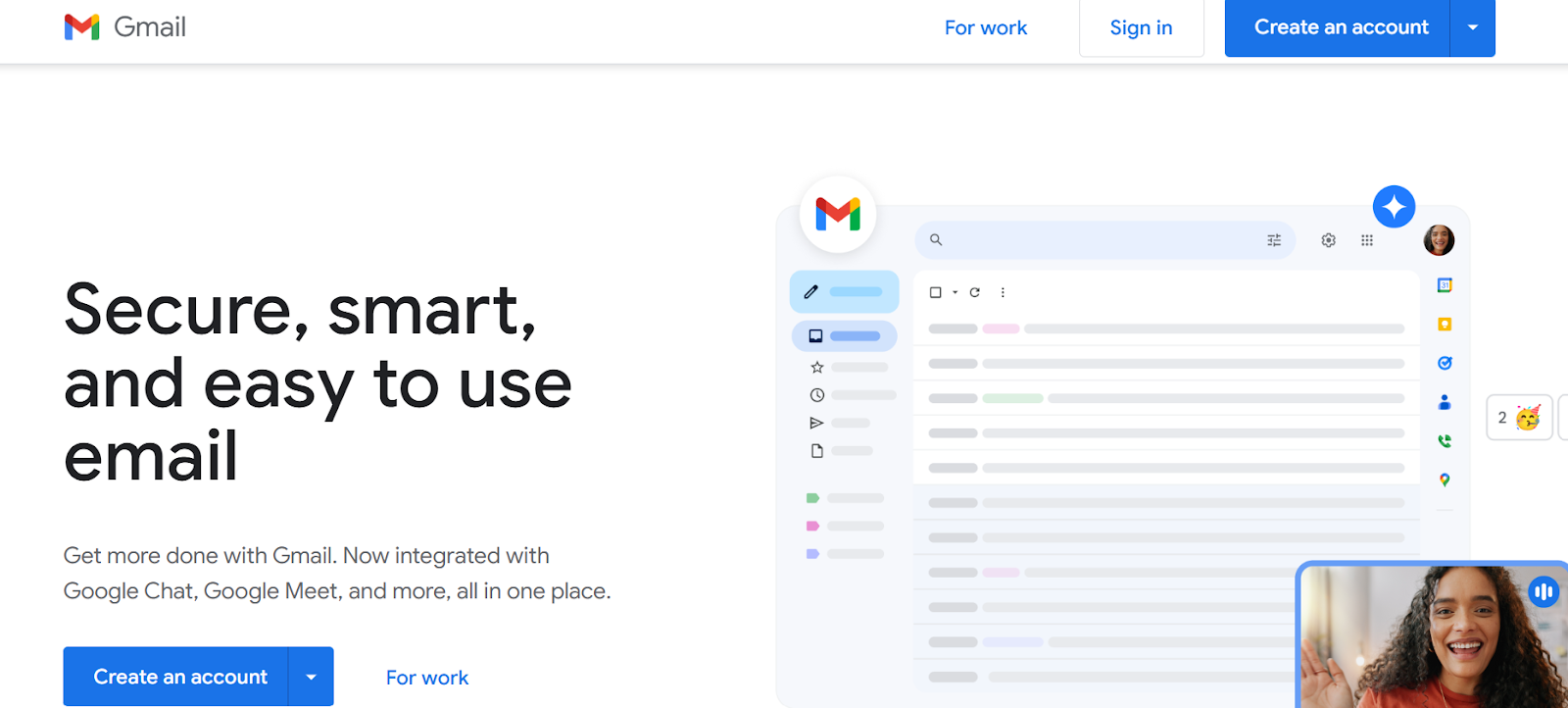
Step 2. Enter your Business Details
Enter your business details, like name, number of employees, and the region.
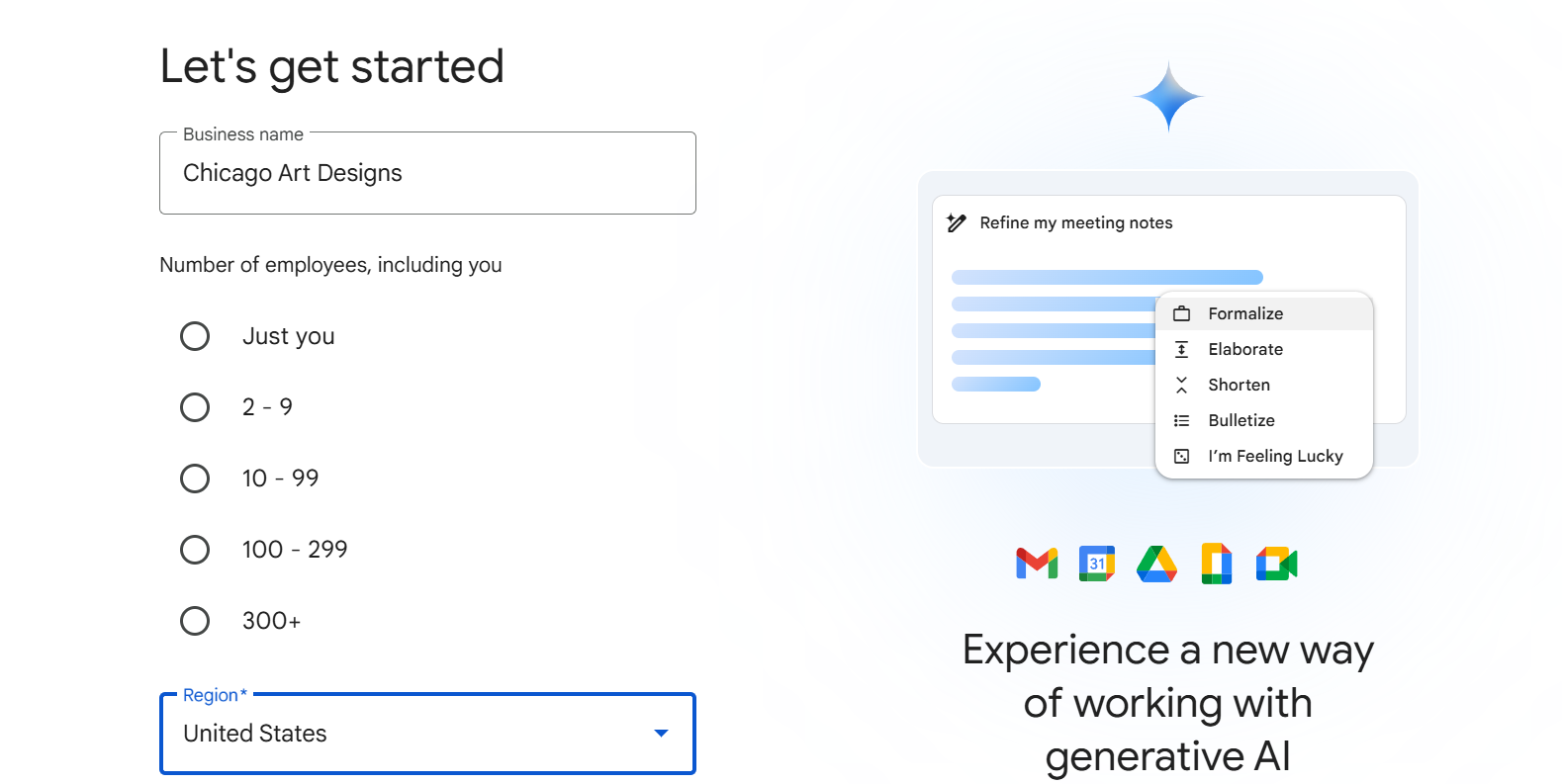
Step 3. Enter your Contact Information
Enter your contact details, like first name, last name, and personal email address.
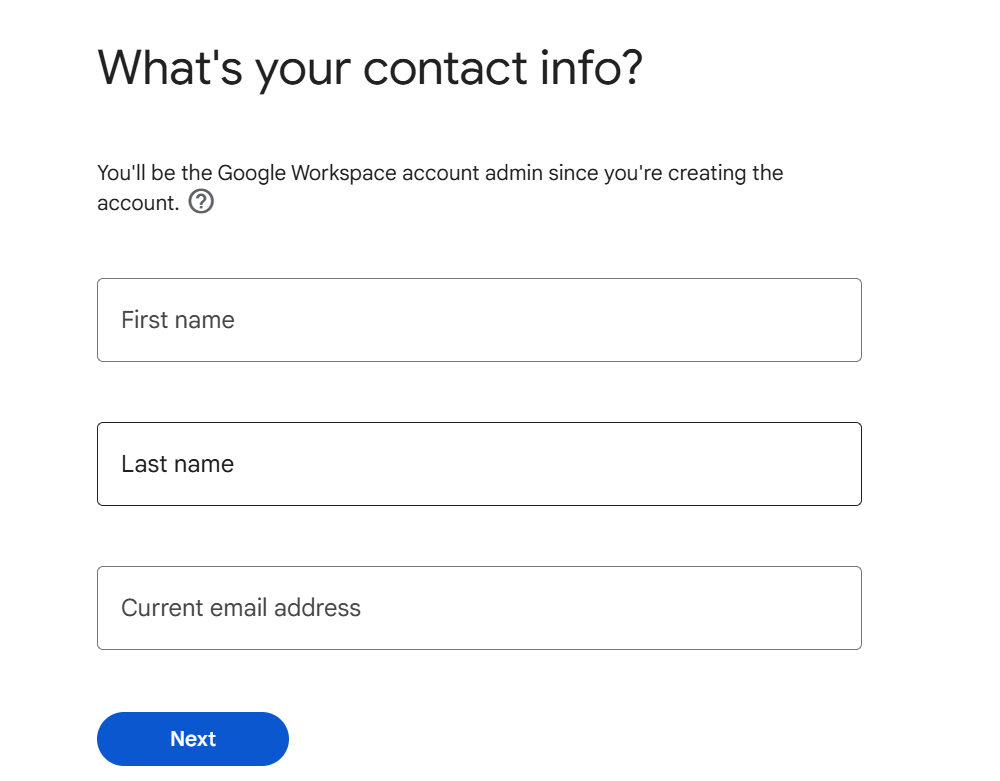
Step 4. Make a Choice Between New Domain or Existing Domain
Now, you will have to choose whether to register a new domain name with Google or use an existing one. The former option is suitable for businesses that have yet to register their domain name, and the latter one is suitable for businesses that already have a domain registered with a domain registrar.
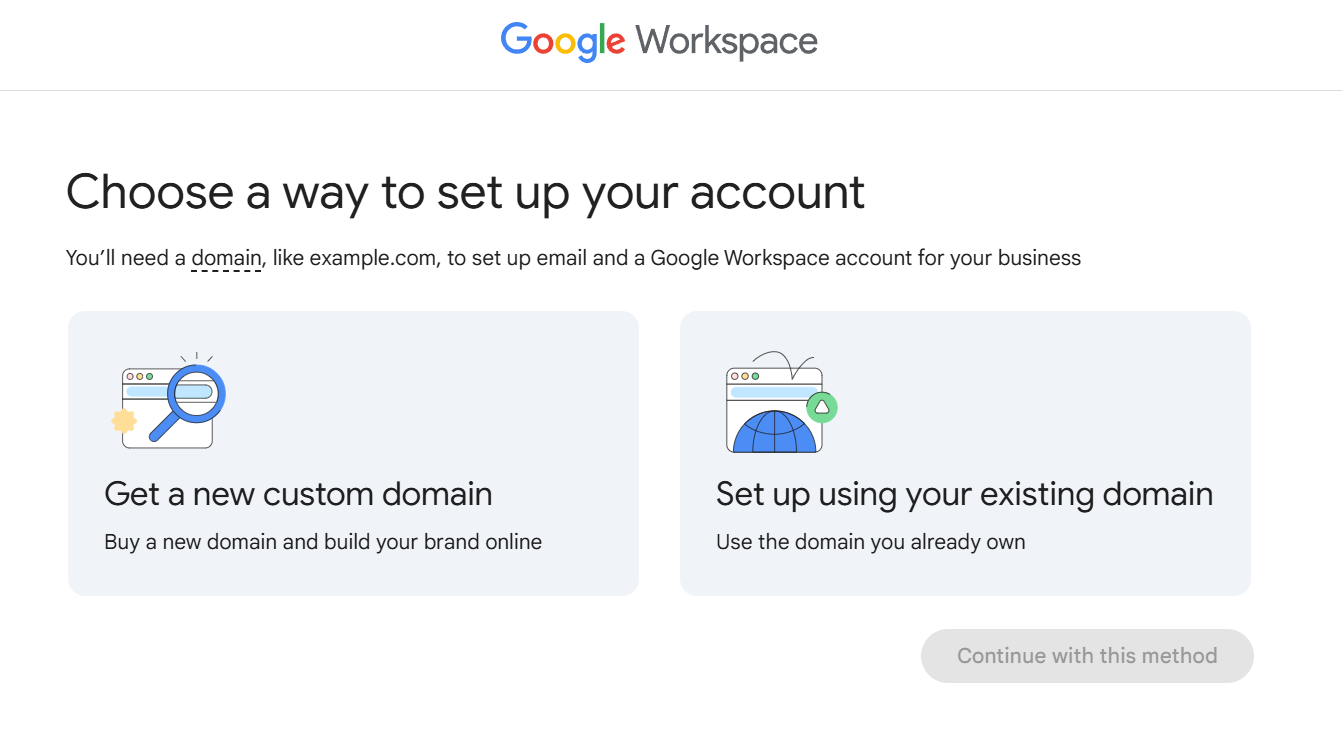
Step 5. Click on the Get a New Custom Domain option (First Scenario)
If you click on the new custom domain name, you will be directed to search for your domain name, which should resemble your business name.
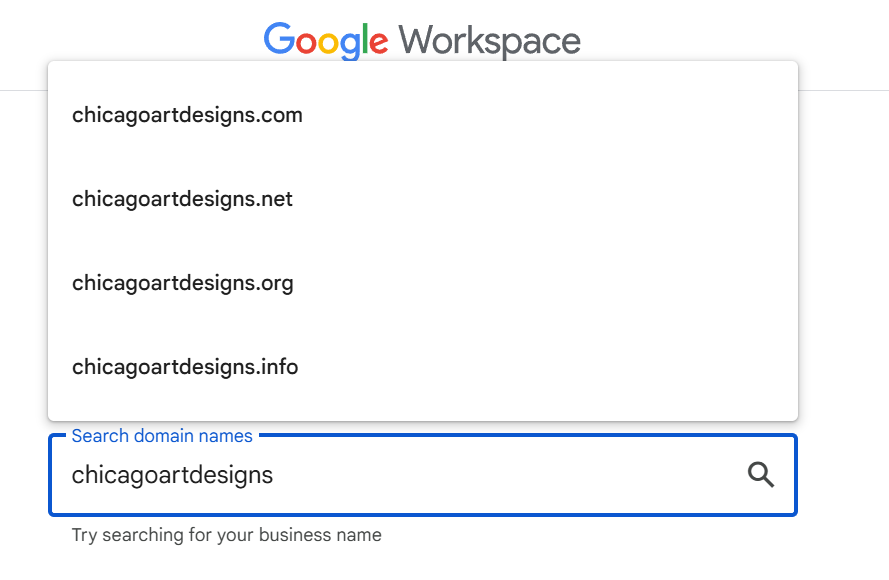
Once you select your desired domain name and click on the search option, you will see the price associated with it to purchase the domain name. Click on next if you want to purchase it.
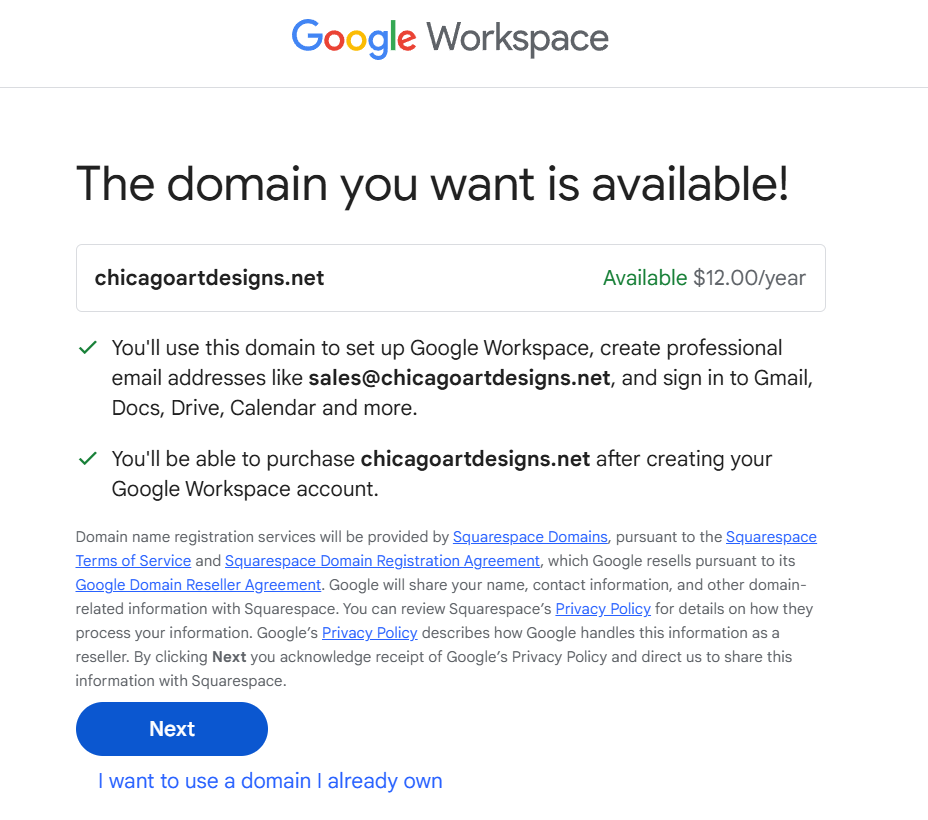
Now, you have to enter your business address and create a Google Workspace account. For this, you have to enter your username and password. The username will have your custom domain name, which is chicagoartdesigns.net, and it will be your admin account.
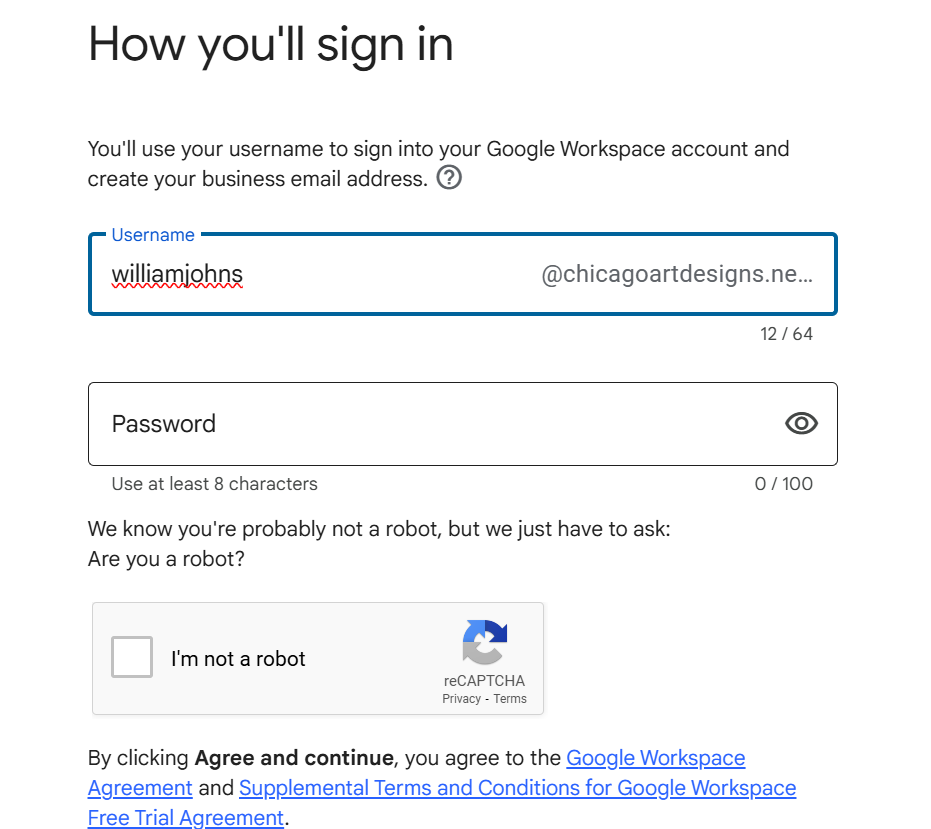
Once everything is done, you will proceed to enter payment details and choose a Google Workspace plan that meets your needs. You can then login to your Gmail account with your business email address.
Step 6. Click on Set up Using your Existing Domain (Second Scenario)
You will have to enter your registered domain name, and Google will verify it. Once the verification is done, you will have to enter your business address information, then you can proceed to create your admin account. Later, you will have to update the MX and TXT records with the domain registrar to get your emails to the new address.

Gmail Features
Gmail assists you with various features that enhance your email experience. Here are some key functionalities to explore:
- Search Functionality: Use the search bar at the top of the inbox to find emails quickly. You can search by sender, subject, or keywords.
- Labels and Folders: Organize your emails using labels and folders. You can create custom labels for different categories of emails and sort them accordingly.
- Filters: Set up filters to automatically sort incoming emails based on specific criteria, such as sender or keywords. This can help maintain an organized inbox.
- Integration with Google Services: Gmail seamlessly integrates with other Google services, such as Google Drive, Google Calendar, and Google Docs, allowing for efficient workflow management.
- Mobile Access: Download the Gmail app on your smartphone for easy access to your emails on the go. The app provides notifications for new emails, making it convenient to stay updated.
5 Best Alternatives to Gmail
While Gmail is a powerful and versatile email service, users may seek alternatives for various reasons. For instance, some users prefer services that do not track their data or display ads. They may opt for more privacy-centric options like ProtonMail or Tutanota.
Businesses with budget restrictions will look for cost-effective alternatives, like Neo. Subsequently, there are integration needs as per the business you’re involved in. Hence, services like Outlook.com or Zoho Mail may offer better integration with your existing software. Likewise, users with high storage needs may find services like Yahoo Mail or GMX Mail more suitable due to their generous storage offerings.
Here are some of the best alternatives to consider:
1. Neo
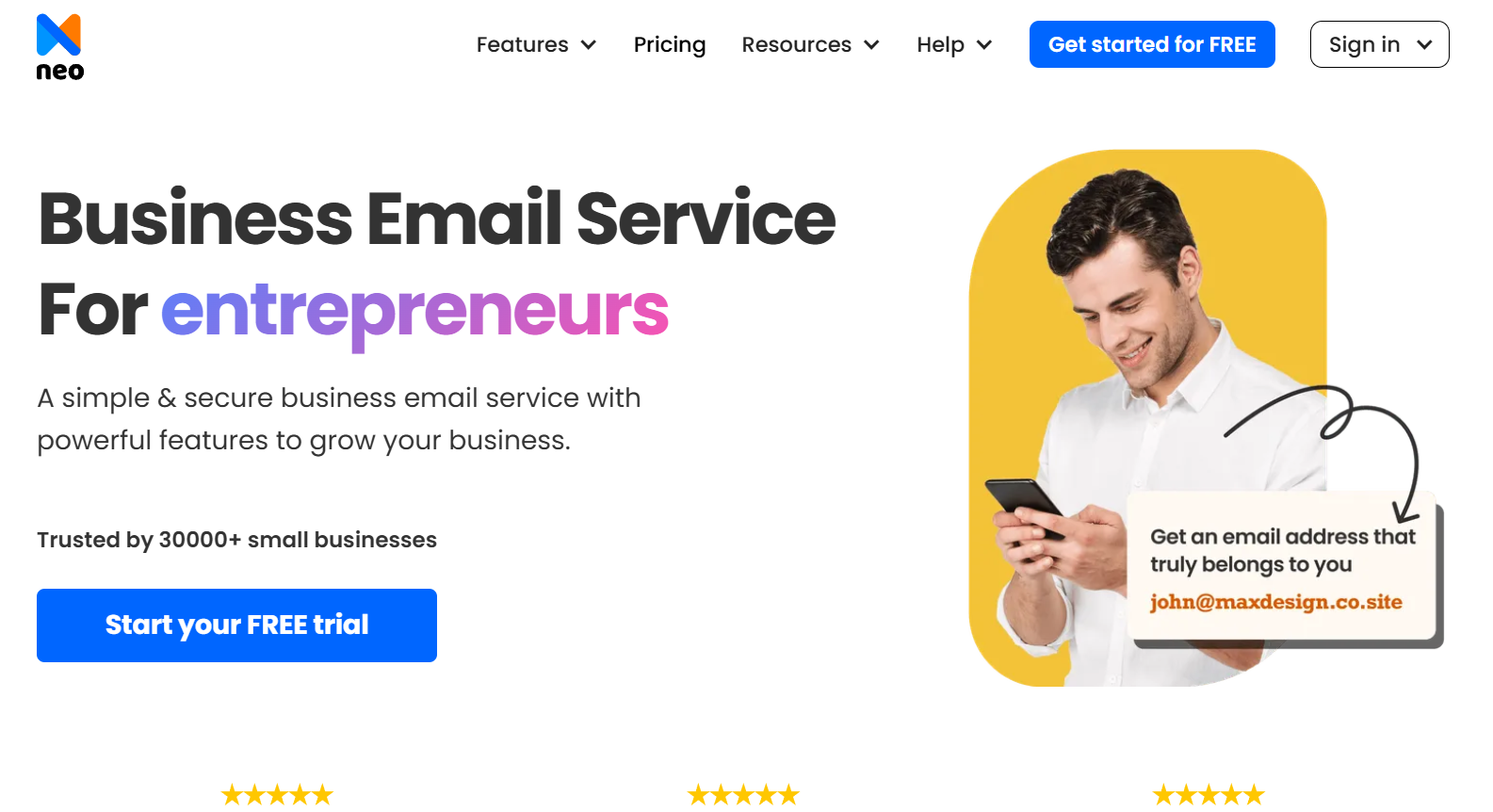
Neo is a modern email service designed to streamline communication for professionals and teams. It focuses on enhancing productivity with smart features.
- Features: Neo offers customizable email workflows, email templates, an AI-powered one-page website, Smart Write, integrated task management, signature designer, and collaboration tools that allow users to work more efficiently. Its interface is clean and user-friendly, making it easy to navigate.
- Best For: Small business teams and professionals looking for an all-in-one solution that combines email with productivity and business management tools.
2. Outlook

Microsoft’s Outlook.com is a robust email service that offers seamless integration with other Microsoft products, such as Office and OneDrive.
- Features: It includes a focused inbox, calendar integration, and excellent organizational tools. Users can also schedule emails to be sent later and utilize a powerful search function.
- Best For: Users who rely heavily on Microsoft products and services.
3. Yahoo Mail
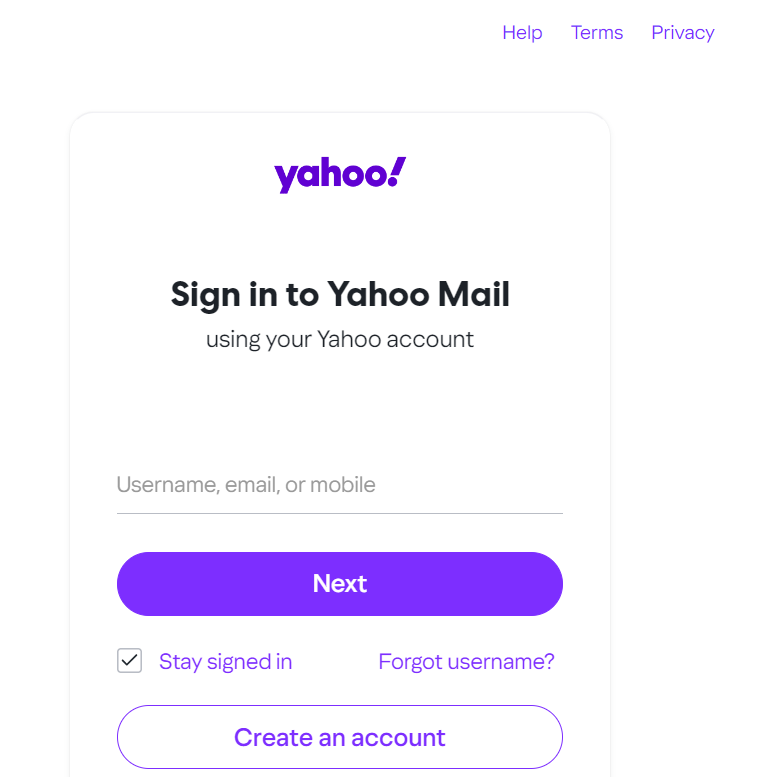
Yahoo Mail has been around for decades and continues to offer a solid email service.
- Features: It provides 1 TB of storage, a customizable interface, and integrated news and weather updates. Yahoo also offers a unique organizational tool that helps manage subscriptions and promotional emails.
- Best For: Users looking for a lot of free storage and customization options.
4. ProtonMail
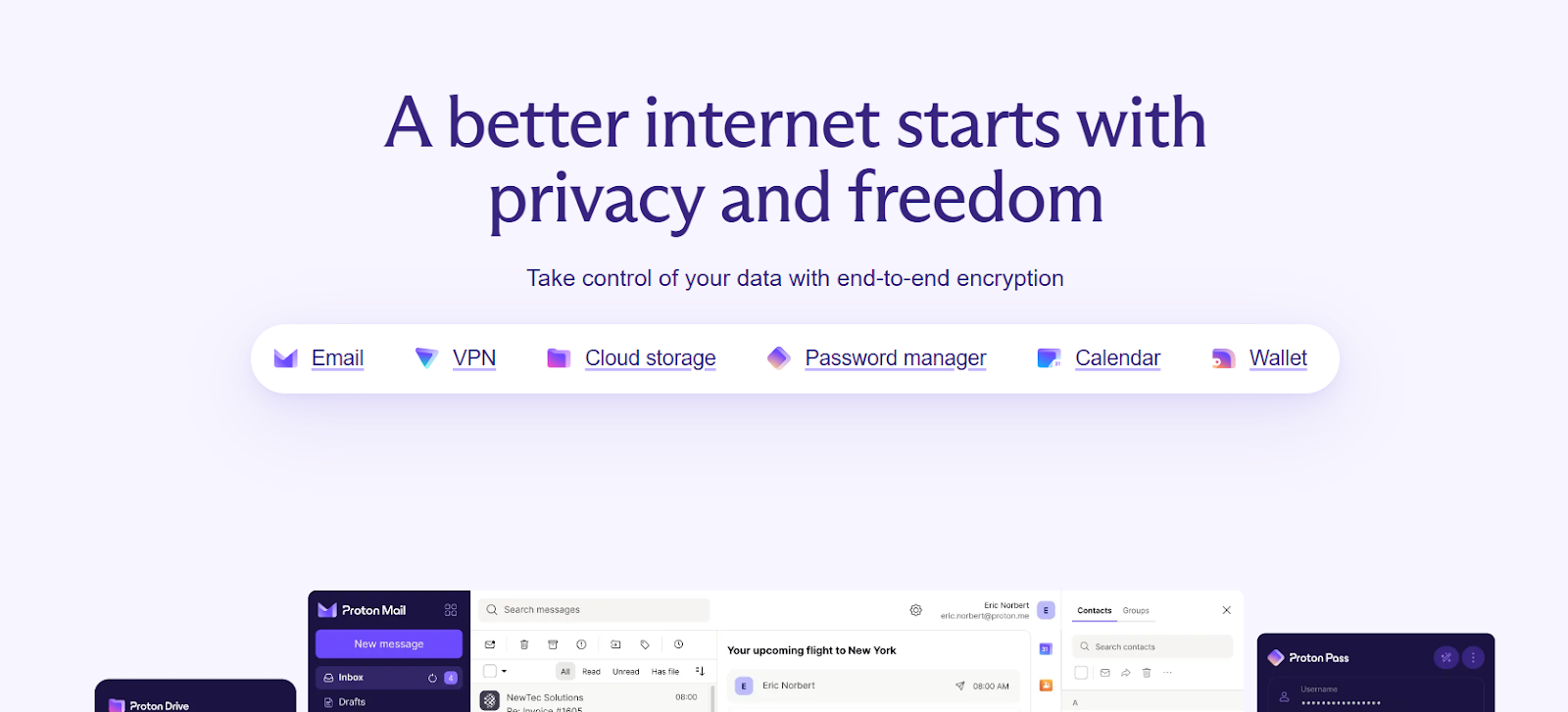
ProtonMail is a privacy-focused email service that emphasizes secure communications. Based in Switzerland, it benefits from strong privacy laws.
- Features: It offers end-to-end encryption, meaning that only the sender and recipient can read the emails. ProtonMail does not track users or display ads, ensuring a secure and private experience.
- Best For: Individuals who prioritize privacy and security in their communications.
5. Zoho Mail

Zoho Mail is part of the larger Zoho suite of business applications. It provides a robust email platform suitable for personal and professional use.
- Features: Zoho Mail includes a clean interface, powerful search capabilities, and collaboration tools. It offers extensive customization options and integrates well with other Zoho applications.
- Best for: Businesses looking for an integrated email solution that also includes CRM, project management, and other tools.
Overall, different email services offer varied user interfaces and experiences. Businesses may require additional features, such as collaboration tools or customer relationship management (CRM) systems, which are better supported by other platforms. You must make an informed decision after considering various factors.
Ultimately, choose the most optimal email service that aligns with your business requirements.
Comparison Table
Note: We have rated different email service providers based on different factors, such as pricing plans, features offered in different plans, security features, ease of use, and email-sending limits.
The Bottom Line,
Signing up for Gmail is straightforward, and you can set up personal and business email accounts for effective communication and increased productivity. With its intuitive interface, robust security features, and seamless integration with other Google services, Gmail remains a top choice for millions of users worldwide.
However, it’s essential to recognize that Gmail is not the only option available. Depending on your specific needs and preferences, various alternatives offer unique features and functionalities that may suit you better. Whether you prioritize privacy, integration with other applications, or storage capacity, there is an email service that can cater to your requirements. As compared to Gmail, Neo offers affordable and easy-to-setup.co.site domains that you can use to set up email addresses for your teams. Visit Neo to create your professional email at $1.84 (the price for the starter plan, which includes custom email domain name registration and a one-page website for free).
Frequently Asked Questions (FAQs)
1. How do I recover my Gmail password?
If you forget your Gmail password, you can recover it by clicking on the “Forgot password?” link on the sign-in page. Google will guide you through the recovery process, which typically involves verifying your identity through a recovery email or phone number.
2. Can I use Gmail without a Google account?
No, you need a Google account to use Gmail. A Gmail account is necessary for full access to all features.
3. Is there a limit to how many emails I can send from Gmail?
Yes, Gmail has a daily sending limit to prevent spam. For personal accounts, the limit is typically 500 emails per day, and for Google Workspace accounts, it is generally 2,000 emails per day.
4. How can I ensure my Gmail account is secure?
To secure your Gmail account, enable two-step verification, use a strong and unique password, regularly update your recovery information, and be cautious about suspicious emails and links.

Get Business Email
No domain name required





.svg%201.svg)
.svg)
.svg)
.svg%201.svg)



